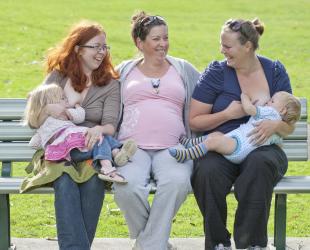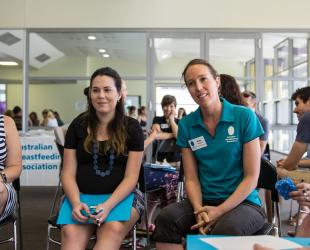Whether your boobs resemble fried eggs, tennis balls, pawpaw or watermelons, there's a breastfeeding technique for you!
by Simone Casey

Whether your boobs resemble fried eggs, tennis balls, pawpaw or watermelons, there's a breastfeeding technique for you! Nipples can be even more varied in size and shape — I've seen thick and thin ones, pointy shaped, inverted, retracted, flat, pink or brown, areolas as big as saucers and ones like little bottle tops, ones that point down, out, up, sideways, or even one of each. Whatever the size or shape, your baby will learn to work with what is on offer! They are your boobs, and they are just right for your baby. When first learning to drive these bosoms of yours, there may be a bit of fiddling around to get everything working the way it should. Here are my best tips to master your booby machinery:
Big ones
- Rolling up a face washer and wedging it underneath your boob helps lift bigger breasts up, so you can better see your baby attach. Holding your breasts with your fingers in the shape of a C can work too.
- Breastfeeding lying down can work well with big breasts, especially as you don't have to change sides, you can just flop the top one over and tuck the lower one out of the way!
Small ones
- The main thing I have to say about small boobs is that they don't mean you'll have any problems producing milk. I've seen mummas with tiny breasts and huge fat bubbas. If you have teeny ones, watch out for breast changes in pregnancy, as the ductal system and breast tissue expands in preparation for milk-making, and that'll reassure you that they'll work fine.
- The supply and demand theory will always ring true – size doesn’t come into it. The more milk your baby sucks out of you, the more milk those boobies will squirt out – size doesn’t come into it.
- Mums with small breasts may notice they have to hold their baby quite high to feed and that breastfeeding pillows you put on your lap don't help much. Holding baby in a more upright position might help too, or baby-led attachment where you lean back a little, with baby lying upright on your chest. When your baby's head control improves, you can have them straddling your leg, which can be quite a comfy pozzy.
Inverted, retracted or flat nipples
- Babies breastfeed, not nipple feed, so no matter what shape your nipples are, you will be able to latch your baby. They may just need a little help while they learn.
- A few tips for mums with flat or inverted nipples — slightly shape the nipple with your hand so there's something for your baby to latch onto. Drawing the nipple out with your fingers or a breast pump before attempting attachment works for some mums.
- If you're still having trouble, wearing a silicone nipple shield for a few weeks can give the baby something to aim for. Once breastfeeding is well established, you can give the shield the flick. Face-to-face support from a lactation consultant or breastfeeding counsellor is important if you want to try using a nipple shield.
Nipples pointing different directions
- Sometimes I get mums with nipple damage on one side and they can't work out why they can get it right on one side but not the other. I often ask them to stand topless in front of the mirror and check what direction their nipples are pointing. What they sometimes discover is they are using the same latching technique for both sides, when the breasts or nipples are not the same at all. Usually an adjustment to the positioning of the baby often works, like lifting baby higher or more around to one side, even holding baby football-style under one arm.
Areola size
- Since areola size can vary, it doesn't really matter how much of the areola is in the baby's mouth during feeding, it just matters how much of the actual breast tissue is in the baby's mouth — so with some mums that means a lot of areola is still visible when baby is attached, but other times you can hardly see any. When more tissue is grasped, the nipple is more likely to be suctioned right back to the soft palate at the back of baby’s mouth, where it will be cushioned for comfortable sucking.
Breast surgeries
- Whether you have breast implants, had a breast lift or breast reduction, or another type of breast surgery, you can still breastfeed, but sometimes may need extra help from the professionals.
- Generally, if you’ve had an augmentation involving implants inserted in the fold of your breast (side or underneath), your milk supply won’t be affected. Sometimes the augmented breasts can feel very firm when engorged after the milk first comes in. This can make it difficult to attach the baby if the nipple is stretched too flat. As with all engorgement, it generally settles after 48 hours and hand expressing or reverse pressure softening techniques can help the nipple come out before latching your baby.
- Unfortunately, breast reductions and lifts involving a ‘lollipop’ incision around the nipple(s) and moving the nipple(s) can affect milk supply as the ducts can be damaged. I wish there was a test or ultrasound available to see whether ducts have been damaged, but sadly, there isn’t. We only really find out if there are problems once the baby starts breastfeeding. I usually talk to mums about doing all the normal things that help to bring in the milk supply, feeding your baby soon after birth, skin to skin contact, frequent feeding and carefully monitor baby’s nappies and weight in the first days after your milk comes in to see if the volumes produced are adequate. If not, a supply line (breastfeeding supplementer) is a great way of giving baby extra milk while maintaining direct breastfeeding and not having to introduce bottles.
Simone Casey is an Australian Breastfeeding Association counsellor and community educator from Northern Melbourne. She’s breastfed three children over nine years and has been volunteering with ABA for over 13 years, with a 6-year stint as group leader of the Pascoe Hume Group and several years as regional representative of the Tullamarine Region. Simone was a journalist for 20 years so has loved combining her writing skills with her breastfeeding knowledge to create blogs for the national website and now recording this podcast series. In 2011 she qualified as an International Board Certified Lactation Consultant and works in a private inner city hospital and runs her own lactation business doing home visits. Her volunteering highlight was at a branch conference in Ballarat when a trainee referred to her as ‘the Kylie Minogue of breastfeeding’.
More information
Many mums wonder about how their boob size or shape might impact on feeding their baby, especially when preparing for their first child. Jess talks to Naomi about breastfeeding with big boobs, little boobs and everything in between. Naomi also answers the question, ‘What do normal boobs look like?'.
- Access our free info kit.
- Download our mum2mum app via the App store or Google Play.
- Call the National Breastfeeding Helpline on 1800 686 268, available 24 hours a day, 7 days a week.
- Chat with a volunteer via LiveChat on our website.
- Sign up for an interactive and informative local breastfeeding class or online breastfeeding workshop.
- Get books and resources on general and specialist breastfeeding topics.
- Join ABA as a member to get your free copy of our best-selling book Breastfeeding … naturally + free access to all premium content on the mum2mum app + discounted breastfeeding classes + half-price breast pump hire + unlimited access to ABA events + more!



